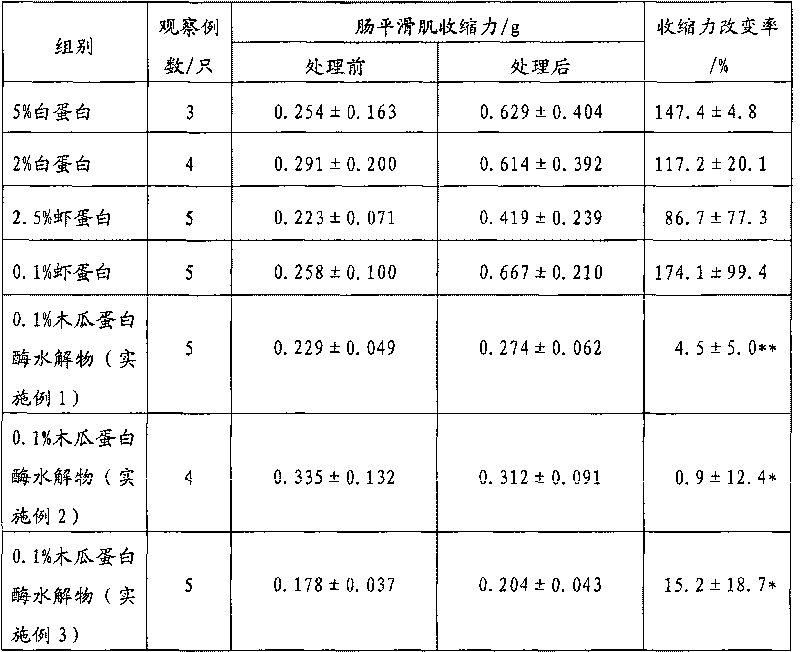Method for preparing low allergen shrimp base material by enzyme method
An enzymatic preparation and allergen technology, which is applied in food preparation, application, food science, etc., can solve the problems of poor food taste, destruction of allergen epitopes, and reduction of protein quality, so as to achieve the effect of eliminating allergens
- Summary
- Abstract
- Description
- Claims
- Application Information
AI Technical Summary
Problems solved by technology
Method used
Image
Examples
Embodiment 1
[0020] 1. Preparation of shrimp paste
[0021] Clean the fresh Litopenaeus vannamei, remove the head and skin to obtain the shrimp meat, add 100g of water for every 10g of the shrimp meat, and use a high-speed tissue mashing machine to make the shrimp meat slurry.
[0022] 2. Papain hydrolyzes shrimp pulp and detects allergic reactions through animal experiments
[0023] (1) Preparation of hydrolyzate
[0024] The prepared shrimp pulp is heated to 60°C and kept warm. The condition of utilizing papain to hydrolyze the shrimp pulp is to add papain in a ratio of 1:100 according to the mass ratio of papain and substrate, at pH 6.5, temperature Hydrolyze at 60°C for 3 hours. Maintain the set pH value during the hydrolysis process. After the hydrolysis, the pH of the hydrolyzate was adjusted to 7.0 with sodium hydroxide solution, and then the enzyme was extinguished at 80° C. for 10 minutes to obtain papain hydrolyzate.
[0025] (2) Anaphylaxis detection
[0026] ① Systemic imm...
Embodiment 2
[0043] 1. Clean the fresh Litopenaeus vannamei, remove the head and skin to get the shrimp meat, add 100g of water for every 15g of shrimp meat, and use a high-speed tissue grinder to make shrimp meat paste.
[0044] 2. Papain hydrolyzes shrimp pulp and detects allergic reactions through animal experiments
[0045] (1) Preparation of hydrolyzate
[0046] The preparation conditions are the same as in Example 1.
[0047] (2) Anaphylaxis detection
[0048] ① The results of the systemic immune test are the same as in Table 1.
[0049] ② The results of allergic contraction test of isolated ileal smooth muscle of sensitized guinea pigs are shown in Table 2.
[0050] The value of the hydrolyzed shrimp protein used in the guinea pig systemic immunity experiment after ELISA detection is: the OD value of the serum reaction between papain hydrolyzate and sea shrimp allergy is 0.054, which is close to the maximum value of normal human serum reaction (normal human serum reaction value ...
Embodiment 3
[0054] 1. Clean the fresh Litopenaeus vannamei, remove the head and skin to obtain the shrimp meat, add 100g of water for every 25g of shrimp meat, and use a high-speed tissue crushing machine to make shrimp meat paste.
[0055] 2. Papain hydrolyzes shrimp pulp and detects allergic reactions through animal experiments
[0056] (1) Preparation of hydrolyzate
[0057] Preparation condition is the same as embodiment 1
[0058] (2) Anaphylaxis detection
[0059] ① The results of the systemic immune test are the same as in Table 1.
[0060] ② The results of allergic contraction test of isolated ileal smooth muscle of sensitized guinea pigs are shown in Table 2.
[0061] The value of the hydrolyzed shrimp protein used in the guinea pig systemic immunity experiment after ELISA detection is: the OD value of the serum reaction between papain hydrolyzate and sea shrimp allergy is 0.057, which is close to the maximum value of normal human serum reaction (normal human serum reaction va...
PUM
 Login to View More
Login to View More Abstract
Description
Claims
Application Information
 Login to View More
Login to View More - R&D
- Intellectual Property
- Life Sciences
- Materials
- Tech Scout
- Unparalleled Data Quality
- Higher Quality Content
- 60% Fewer Hallucinations
Browse by: Latest US Patents, China's latest patents, Technical Efficacy Thesaurus, Application Domain, Technology Topic, Popular Technical Reports.
© 2025 PatSnap. All rights reserved.Legal|Privacy policy|Modern Slavery Act Transparency Statement|Sitemap|About US| Contact US: help@patsnap.com

